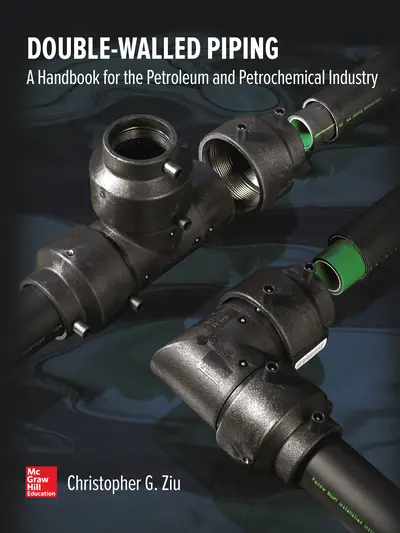My Account Details

ISBN10: 0071841725 | ISBN13: 9780071841726

Step 1 . Download Adobe Digital Editions to your PC or Mac desktop/laptop.
Step 2. Register and authorize your Adobe ID (optional). To access your eBook on multiple devices, first create an Adobe ID at account.adobe.com. Then, open Adobe Digital Editions, go to the Help menu, and select "Authorize Computer" to link your Adobe ID.
Step 3. Open Your eBook. Use Adobe Digital Editions to open the file. If the eBook doesn’t open, contact customer service for assistance.
Publisher's Note: Products purchased from Third Party sellers are not guaranteed by the publisher for quality, authenticity, or access to any online entitlements included with the product.
Comprehensive coverage of double-walled piping system design, installation, and operation
This definitive text provides expert guidance on the design, layout, installation, and maintenance of double-walled piping systems. Double-Walled Piping: A Handbook for the Petroleum and Petrochemical Industry takes you through the construction of both under- and above-ground systems and features complete details on system selection and installation, leak detection, tanks, and testing. Advanced chapters cover design methods and multinational approaches to determining size and performance criteria. You will also get an up-to-date overview of global practices, methods, laws, and requirements.
Coverage includes:
• Materials of construction
• System selection
• Fluid dynamics and sizing analysis
• Design of metallic and nonmetallic primary components
• Design of secondary containment components
• Thermal expansion considerations
• Structural considerations
• Heat transfer in double containment piping
• Layout concepts for double containment piping
• Fabrication, installation, inspection, examination, and testing
• Associated storage tanks and pressure vessels
• Leak detection
• Trenchless installation and alternatives to secondary containment piping
1.1 History of Double Containment Piping
1.2 Ground Water Technology and Ground Water Contamination
1.3 The Concept of Double Containment
1.4 Leak Detection and Monitoring
1.5 Design of Piping Systems
1.6 Design of Double Containment Piping Systems
2 Materials of Construction
2.1 Fundamentals of Metallic Corrosion
2.2 Metallic Materials Used in Chemical Services
2.3 Fundamentals of Nonmetallic Materials in Corrosive Media
2.4 Nonmetallic Materials Used in Piping and Tanks
2.5 Corrosion Testing Methods
2.6 Sources of Corrosion Data
3 System Selection
3.1 General Statements
3.2 Classification of Material Combinations
4 Fluid Dynamics and Sizing Analysis
4.1 General Fluid Considerations
4.2 Flow in Pressure Pipes
4.3 Pressure Flow in Annuli (Secondary Containment Piping Considerations)
4.4 Flow of Fluids in Chemical Process Sewer and DWV Piping
4.5 Gravity Flow in Annuli and Venting of Annuli
5 Design of Metallic Primary Components
5.1 Design Criteria and Conditions
5.2 Pressure Design of Primary (Core) Piping Components
5.3 Selecting Primary (Carrier) Piping Components for Fluid Services
5.4 Selecting Joining Methods for Fluid Services
5.5 Flexibility and Support
5.6 Auxiliary Piping Systems
6 Design of Nonmetallic Primary Components
6.1 Design Issues for Nonmetallic Primary Piping Components
6.2 Design Criteria for Nonmetallic Primary Piping Components
6.3 Pressure Design of Nonmetallic Primary Piping Components
6.4 Selecting Nonmetallic Piping Components for Fluid Services
6.5 Selecting Nonmetallic Piping Joining Methods for Primary Pipe Fluid Services
6.6 Flexibility and Support of Nonmetallic Primary Piping
7 Design of Secondary Containment Components (Metallic and Nonmetallic Materials)
7.1 Introduction
7.2 Conditions and Criteria for Secondary Containment Components
7.3 Design Criteria for Secondary Containment Components
7.4 Pressure Design of Secondary Containment Piping Components
7.5 Selecting Secondary Containment Piping Components and Joining Methods for Fluid Services
7.6 Secondary Containment Piping Support
7.7 Auxiliary Piping Systems
8 Thermal Expansion Considerations
8.1 Thermal Expansion
8.2 Axial Stress Calculations
8.3 Simplified and Comprehensive Stress Analysis
8.4 Stresses in Interconnecting Components
8.5 Totally Restrained Double Containment Piping Systems
8.6 Methods for Alleviation of Expansion and Contraction
8.7 Use of Heat Transfer as a Controlling Medium
8.8 Classification of Systems and Application of Compensation Techniques
9 Structural Considerations
9.1 General
9.2 Longitudinal Bending Analysis
9.3 Support of Primary Piping and Nonburied Assemblies
9.4 Burial Considerations
10 Heat Transfer in Double Containment Piping
10.1 General
10.2 Heat Transfer Theory Applied to Double Containment Pipe Assemblies
11 Layout Concepts for Double Containment Piping
11.1 Pressure Piping Systems
11.2 Layout Details for Double Containment Pressure Fittings
11.3 Nonpressure System Layout and General Underground Considerations
11.4 Layout Details of Double Containment Drainage Fittings
11.5 Petroleum Station Double Containment Piping Layout
11.6 Multiple-Primary-Pipe/Common Secondary Containment Pipe Systems
11.7 Valves and Valve Layout for Double Containment Piping Systems
12 Fabrication and Installation
12.1 Metallic Component Considerations
12.2 Nonmetallic Component Considerations
12.3 Double Containment Piping Installation Issues
13 Inspection, Examination, and Testing
13.1 Metallic Component Considerations
13.2 Nonmetallic Component Considerations
13.3 Considerations for Double Containment Assemblies
14 Associated Storage Tanks and Pressure Vessels
14.1 Overview
14.2 Storage Tan
Need support? We're here to help - Get real-world support and resources every step of the way.